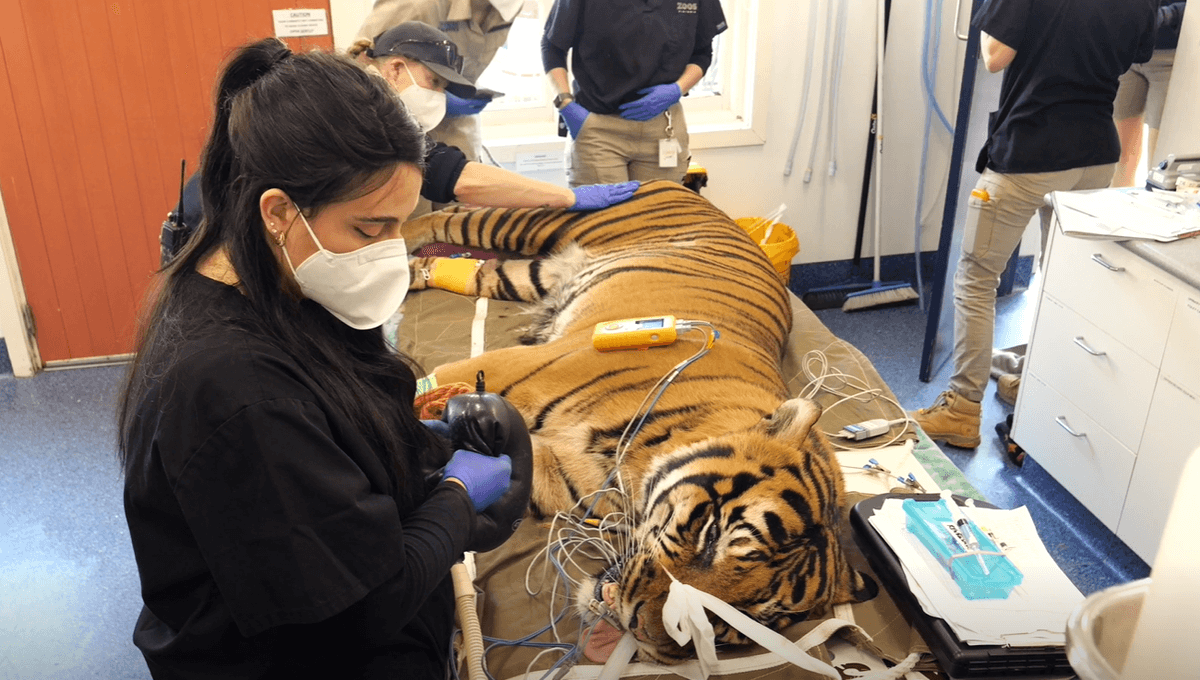
A tiger at Melbourne Zoo has received three root canals on damaged teeth in a dental procedure that started challenging and ended up extravagant. Fortunately, Hutan, the tiger in question, has awoken no worse for wear, and the vet and keeper have all their limbs intact.
Teeth are important for most of the animals that possess them, but particularly for apex predators. “In the wild, a tiger would not be able to hunt if their canines were affected,” Melbourne Zoo Carnivores Life Sciences manager Laura Weiner told IFLScience.
One might expect that something so mission-critical would have evolved to survive whatever conditions can throw at it, but Weiner added that broken teeth are a major hazard for wild tigers. The potential to have teeth fixed is a significant reason why tigers in captivity live to 15-20 years, while wild tigers seldom do, although even the captive life expectancy shows size doesn’t equal longevity for felines.
We got out as fast as possible.
Laura Weiner
At 15, Hutan is now classified as a “geriatric tiger”, but that doesn’t affect the standard of care he receives. Keepers had noticed that two of his canine teeth had cracked, which they attribute to biting too hard on bones. Hutan was scheduled for a 90-minute procedure where both teeth would be fixed, but in the process, the veterinary dentist noted some previous dental work had failed. Rather than capturing him and putting him under again at some future date, it was decided to extend the anesthesia and fix the third tooth as well.
“A root canal is taking out the dead nerve and removing the pain from the tooth, so after this procedure, he’ll be a much happier cat and be back to chomping on bones in no time,” Weiner said in an emailed statement.
Indeed, Weiner added to IFLScience, in the week since the operation, Hutan has appeared very healthy. Then again, she noted, he hadn’t shown any signs of discomfort beforehand, which is probably just as well because a grumpy 110-kilogram (240-pound) Sumatran tiger wouldn’t be fun for anyone, even in a secure enclosure.
You’re suddenly face to face with this incredibly powerful animal, and yet in that moment, you’re focused on something as small and delicate as a tooth.
Laura Weiner
“The dentist always takes radiographs” when working on the animals, Weiner told IFLScience, to check for any other damage. Zoo staff also performed a full-body exam while Hutan was out cold. Otherwise, however, Weiner said, “We got out as fast as possible.” No hanging around to give the teeth a polish, apparently.
For anyone considering a career in tooth care for apex predators, Weiner said she cannot speak for other countries, but in the US, where she is from, they are vets who specialize in dentistry, not dentists who expand their clients. Zoos Victoria has generalist vets on staff, but for big cat dental work, they call in a specialist who mostly works on domestic felines. The size may change, but the general shape is similar.
Having Hutan on the treatment table reminded Weiner of the scale of her charges. “You’re suddenly face to face with this incredibly powerful animal, and yet in that moment, you’re focused on something as small and delicate as a tooth,” she said. “It’s a real privilege to be able to care for him in that way and provide him relief from pain.”
Source Link: Tiger And Vet Survive Triple Root Canal